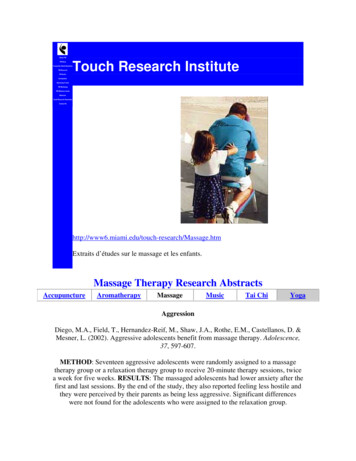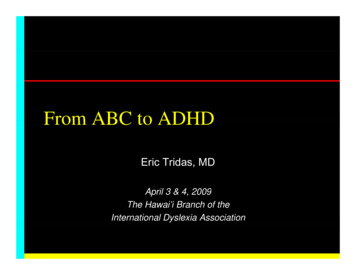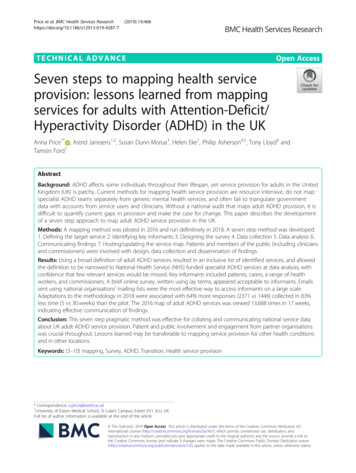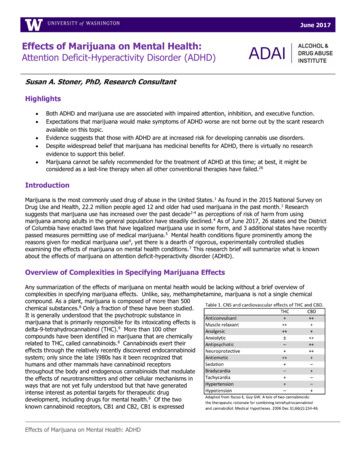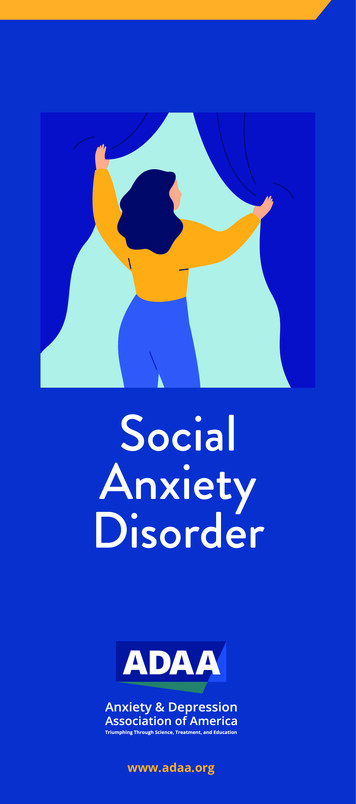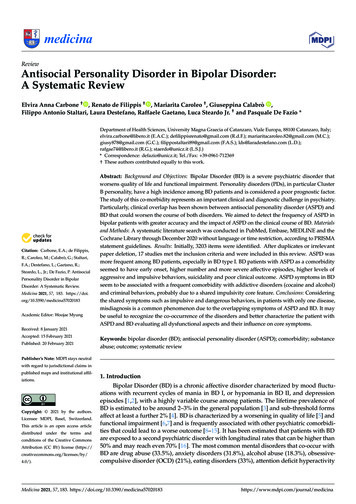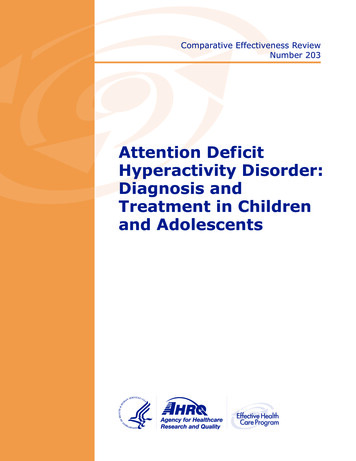
Transcription
Comparative Effectiveness ReviewNumber 203Attention DeficitHyperactivity Disorder:Diagnosis andTreatment in Childrenand Adolescentse
Comparative Effectiveness ReviewNumber 203Attention Deficit Hyperactivity Disorder: Diagnosisand Treatment in Children and AdolescentsPrepared for:Agency for Healthcare Research and QualityU.S. Department of Health and Human Services5600 Fishers LaneRockville, MD 20857www.ahrq.govContract No. 290-2015-00004-IPrepared by:Duke Evidence-based Practice CenterDurham, NCInvestigators:Alex R. Kemper, M.D., M.P.H, M.S.Gary R. Maslow, M.D., M.P.H.Sherika Hill, M.H.A., Ph.D.Behrouz Namdari, M.D.Nancy M. Allen LaPointe, Pharm.D., M.H.S.Adam P. Goode, D.P.T., Ph.D.Remy R. Coeytaux, M.D., Ph.D.Deanna Befus, B.A., B.S.N.Andrzej S. Kosinski, Ph.D.Samantha E. Bowen, Ph.D.Amanda J. McBroom, Ph.D.Kathryn R. Lallinger, M.S.L.S.Gillian D. Sanders, Ph.D.AHRQ Publication No. 18-EHC005-EFJanuary 2018
Key MessagesPurpose of ReviewTo update a previous review by comparing strategies to diagnose, treat, and monitor children andadolescents with attention deficit hyperactivity disorder (ADHD).Key Messages Evidence was insufficient on imaging or electroencephalogram to diagnose ADHD inchildren 7–17 years of age. Little evidence adds to the 2011 report that found that methylphenidate is effective forchildren under age 6 with ADHD and that psychostimulants can be effective for children6–12 years of age. Atomoxetine had slightly higher gastrointestinal effects than methylphenidate. Cognitive behavioral therapy may improve ADHD symptoms among children 7–17 yearsof age. Child or parent training improved ADHD symptoms among children 7–17 years of agebut did not change academic performance. Omega-3/6 supplementation made no difference in ADHD symptoms. Future studies are needed to evaluate diagnosis, monitoring, and long-term outcomes forchildren and adolescents with ADHD managed in usual care settings.ii
This report is based on research conducted by the Duke Evidence-based Practice Center (EPC)under contract to the Agency for Healthcare Research and Quality (AHRQ), Rockville, MD(Contract No. 290-2015-00004-I). The findings and conclusions in this document are those of theauthors, who are responsible for its contents; the findings and conclusions do not necessarilyrepresent the views of AHRQ. Therefore, no statement in this report should be construed as anofficial position of AHRQ or of the U.S. Department of Health and Human Services.None of the investigators have any affiliations or financial involvement that conflicts withthe material presented in this report.The information in this report is intended to help health care decisionmakers—patients andclinicians, health system leaders, and policymakers, among others—make well-informeddecisions and thereby improve the quality of health care services. This report is not intended tobe a substitute for the application of clinical judgment. Anyone who makes decisions concerningthe provision of clinical care should consider this report in the same way as any medicalreference and in conjunction with all other pertinent information, i.e., in the context of availableresources and circumstances presented by individual patients.This report is made available to the public under the terms of a licensing agreement between theauthor and the Agency for Healthcare Research and Quality. This report may be used andreprinted without permission except those copyrighted materials that are clearly noted in thereport. Further reproduction of those copyrighted materials is prohibited without the expresspermission of copyright holders.AHRQ or U.S. Department of Health and Human Services endorsement of any derivativeproducts that may be developed from this report, such as clinical practice guidelines, otherquality enhancement tools, or reimbursement or coverage policies, may not be stated or implied.This report may periodically be assessed for the currency of conclusions. If an assessment isdone, the resulting surveillance report describing the methodology and findings will be found onthe Effective Health Care Program Web site at www.effectivehealthcare.ahrq.gov. Search on thetitle of the report.Persons using assistive technology may not be able to fully access information in this report. Forassistance contact epc@ahrq.hhs.gov.Suggested citation: Kemper AR, Maslow GR, Hill S, Namdari B, Allen LaPointe NM, GoodeAP, Coeytaux RR, Befus D, Kosinski AS, Bowen SE, McBroom AJ, Lallinger KR, Sanders GD.Attention Deficit Hyperactivity Disorder: Diagnosis and Treatment in Children and Adolescents.Comparative Effectiveness Review No. 203. (Prepared by the Duke University Evidence-basedPractice Center under Contract No. 290-2015-00004-I.) AHRQ Publication No. 18-EHC005-EF.Rockville, MD: Agency for Healthcare Research and Quality; January 2018. Posted final reportsare located on the Effective Health Care Program search page.DOI: https://doi.org/10.23970/AHRQEPCCER203.iii
PrefaceThe Agency for Healthcare Research and Quality (AHRQ), through its Evidence-basedPractice Centers (EPCs), sponsors the development of systematic reviews to assist public- andprivate-sector organizations in their efforts to improve the quality of health care in the UnitedStates. These reviews provide comprehensive, science-based information on common, costlymedical conditions, and new health care technologies and strategies.Systematic reviews are the building blocks underlying evidence-based practice; they focusattention on the strength and limits of evidence from research studies about the effectiveness andsafety of a clinical intervention. In the context of developing recommendations for practice,systematic reviews can help clarify whether assertions about the value of the intervention arebased on strong evidence from clinical studies. For more information about AHRQ EPCsystematic reviews, see .cfm.AHRQ expects that these systematic reviews will be helpful to health plans, providers,purchasers, government programs, and the health care system as a whole. Transparency andstakeholder input are essential to the Effective Health Care Program. Please visit the Web site(www.effectivehealthcare.ahrq.gov) to see draft research questions and reports or to join anemail list to learn about new program products and opportunities for input.If you have comments on this systematic review, they may be sent by mail to the Task OrderOfficer named below at: Agency for Healthcare Research and Quality, 5600 Fishers Lane,Rockville, MD 20857, or by email to epc@ahrq.hhs.gov.Gopal Khanna, M.B.A.DirectorAgency for Healthcare Research and QualityArlene S. Bierman, M.D., M.S.DirectorCenter for Evidence and PracticeImprovementAgency for Healthcare Research and QualityStephanie Chang, M.D., M.P.H.DirectorEvidence-based Practice Center ProgramCenter for Evidence and Practice ImprovementAgency for Healthcare Research and QualitySuchitra Iyer, Ph.D.Task Order OfficerCenter for Evidence and PracticeImprovementAgency for Healthcare Research and Qualityiv
AcknowledgmentsThe authors thank Naomi Davis, Ph.D., for providing clinical expertise; Megan von Isenburg,M.S.L.S., for help with the literature search and retrieval; Robyn E. Schmidt, B.A., for assistancewith project coordination; and Rebecca N. Gray, D.Phil., and Liz Wing, M.A., for editorialassistance.Key InformantsIn designing the study questions, the EPC consulted several Key Informants who represent theend-users of research. The EPC sought the Key Informant input on the priority areas for researchand synthesis. Key Informants are not involved in the analysis of the evidence or the writing ofthe report. Therefore, in the end, study questions, design, methodological approaches, and/orconclusions do not necessarily represent the views of individual Key Informants.Key Informants must disclose any financial conflicts of interest greater than 10,000 and anyother relevant business or professional conflicts of interest. Because of their role as end-users,individuals with potential conflicts may be retained. The TOO and the EPC work to balance,manage, or mitigate any conflicts of interest.The list of Key Informants who provided input to this report follows:Barry Anton, Ph.D., A.B.P.P.Rainier Behavioral HealthTacoma, WALaurence Greenhill, M.D.Columbia University Medical CenterNew York, NYWilliam Barbaresi, M.D., FAAPBoston Children’s HospitalBoston, MAAaron Lopata, M.D., M.P.P.Health Resources and Services AdministrationMaternal and Child Health BureauRockville, MDColeen Boyle, Ph.D., M.S.Hyg.Centers for Disease Control and PreventionAtlanta, GADoris Lotz, M.D., M.P.H.Chief Medical OfficerNew Hampshire Department of Health andHuman ServicesConcord, NHTeka DempsonNational Federation of Families for Children’sMental HealthDurham, NCMark Wolraich, M.D.University of Oklahoma Health SciencesCenterOklahoma City, OKTheodore Ganiats, M.D.University of MiamiMiami, FLv
Technical Expert PanelIn designing the study questions and methodology at the outset of this report, the EPC consultedseveral technical and content experts. Broad expertise and perspectives were sought. Divergentand conflicting opinions are common and perceived as healthy scientific discourse that results ina thoughtful, relevant systematic review. Therefore, in the end, study questions, design,methodologic approaches, and/or conclusions do not necessarily represent the views ofindividual technical and content experts.Technical Experts must disclose any financial conflicts of interest greater than 10,000 and anyother relevant business or professional conflicts of interest. Because of their unique clinical orcontent expertise, individuals with potential conflicts may be retained. The TOO and the EPCwork to balance, manage, or mitigate any potential conflicts of interest identified.The list of Technical Experts who provided input to this report follows:Coleen Boyle, Ph.D., M.S.Hyg.*Centers for Disease Control and PreventionAtlanta, GASusanna Visser, M.S., Dr.Ph.*Centers for Disease Control and PreventionAtlanta, GATheodore Ganiats, M.D.University of MiamiMiami, FLMark Wolraich, M.D.*University of Oklahoma Health SciencesCenterOklahoma City, OKLaurence Greenhill, M.D.*Columbia University Medical CenterNew York, NYJulie Zito, Ph.D.*University of MarylandBaltimore, MDWilliam E. Pelham, Jr., Ph.D.*Florida International UniversityMiami, FLErin Schoenfelder Gonzalez, Ph.D.*Seattle Children’s HospitalSeattle, WA*Provided input on Draft Report.vi
Peer ReviewersPrior to publication of the final evidence report, EPCs sought input from independent PeerReviewers without financial conflicts of interest. However, the conclusions and synthesis of thescientific literature presented in this report do not necessarily represent the views of individualreviewers.Peer Reviewers must disclose any financial conflicts of interest greater than 10,000 and anyother relevant business or professional conflicts of interest. Because of their unique clinical orcontent expertise, individuals with potential nonfinancial conflicts may be retained. The TOOand the EPC work to balance, manage, or mitigate any potential nonfinancial conflicts of interestidentified.The list of Peer Reviewers follows:Charles J. Homer, M.D., M.P.H.Harvard TH Chan School of Public HealthBoston, MAPeter Jensen, M.D.Mayo ClinicRochester, MNvii
Attention Deficit Hyperactivity Disorder: Diagnosisand Treatment in Children and AdolescentsStructured AbstractObjectives. Attention deficit hyperactivity disorder (ADHD) is a common pediatricneurobehavioral disorder often treated in the primary care setting. This systematic reviewupdates and extends two previous Agency for Healthcare Research and Quality (AHRQ)systematic evidence reviews and focuses on the comparative effectiveness of methods toestablish the diagnosis of ADHD, updates the comparative effectiveness of pharmacologic andnonpharmacologic treatments, and evaluates different monitoring strategies in the primary caresetting for individuals from birth through 17 years of age.Data sources. We searched PubMed , Embase , PsycINFO , and the Cochrane Database ofSystematic Reviews for relevant English-language studies published from January 1, 2011,through November 7, 2016.Review methods. Two investigators screened each abstract and full-text article for inclusion,abstracted the data, and performed quality ratings and evidence grading. Random-effects modelswere used to compute summary estimates of effects when sufficient data were available formeta-analysis.Results. Evidence was contributed from 103 articles describing 90 unique studies. Twenty-onestudies related to diagnosis, 69 studies related to treatment, and no studies were identified onmonitoring. The Attention and Executive Function Rating Inventory and Childhood ExecutiveFunctioning Inventory performed better than the Cambridge Neuropsychological TestAutomated Battery for the diagnosis of ADHD for ages 7–17 years (strength of evidence[SOE] low). Evidence was insufficient on the use of electroencephalography (EEG) orneuroimaging to establish the diagnosis of ADHD for ages 7–17 years. No studies directlyassessed the harms to children labeled as having ADHD. Limited additional evidence publishedsince the original 2011 report was available on ADHD medications approved by the Food andDrug Administration (FDA) compared with placebo or compared to different FDA-approvedADHD medications (SOE insufficient). For atomoxetine and methylphenidate, the mostcommonly reported adverse events were somnolence and mild gastrointestinal problems.Atomoxetine had slightly higher gastrointestinal effects than methylphenidate (SOE low).Cognitive behavioral therapy improved ADHD symptoms (SOE low). Child or parent trainingimproved ADHD symptoms (SOE moderate) but made no difference in academic performance(SOE low). Omega-3/6 fatty acid supplementation made no difference in ADHD symptoms(SOE moderate). Across all treatments, little evidence was reported on the risk of seriousadverse events, including cardiovascular risk.Conclusions. The 2011 AHRQ systematic review highlighted the benefit of psychostimulants forchildren 6–12 years of age with ADHD for up to 24 months and found that addingpsychosocial/behavioral interventions to psychostimulants is more effective thanpsychosocial/behavioral interventions alone for children with ADHD and oppositional defiantdisorder. This targeted update found insufficient evidence regarding new approaches to theviii
diagnosis (e.g., EEGs, neuroimaging). Little is known about the impact of being labeled ashaving ADHD. Although cognitive behavioral therapy or child or parent training may decreasesymptoms of ADHD, more information is needed regarding the relative benefit of theseapproaches compared to, or combined with, medication treatment. Omega-3/6 supplementationdoes not appear to improve ADHD outcomes. No information was identified regarding theoptimal strategy for monitoring after diagnosis.ix
ContentsIntroduction . 1Background . 1Population . 1Diagnosis. 2Treatment Strategies . 2Monitoring Strategies With Intermediate Outcomes . 3Long-Term Outcomes . 3Key Findings From 2011 Report . 4Scope and Key Questions . 5Scope of This Review . 5Key Questions . 6Organization of This Report . 8Methods . 9Topic Refinement and Review Protocol . 9Literature Search Strategy. 9Search Strategy . 9Inclusion and Exclusion Criteria. 10Study Selection . 15Data Extraction . 16Quality Assessment of Individual Studies . 16Data Synthesis . 17Strength of the Body of Evidence . 18Applicability . 20Peer Review and Public Commentary . 20Results . 21Results of Literature Searches . 21Description of Included Studies: Overview . 23Key Question 1: ADHD Diagnosis . 26Description of Included Studies . 34Key Points . 34Detailed Synthesis—Diagnosis . 34Strength of Evidence—Diagnosis . 35Key Question 2: ADHD Treatment . 38Description of Included Studies . 38Key Point for Pharmacologic Versus Placebo/Usual Care . 38Detailed Synthesis—Pharmacologic Versus Placebo/Usual Care . 38Findings in Relation to What Is Already Known—Pharmacologic Versus Placebo/UsualCare . 41Strength of Evidence—Pharmacologic Versus Placebo/Usual Care . 42Key Points for Pharmacologic Versus Pharmacologic . 45Detailed Synthesis—Pharmacologic Versus Pharmacologic. 45Findings in Relation to What Is Already Known—Pharmacologic Versus Pharmacologic 47Strength of Evidence—Pharmacologic Versus Pharmacologic . 48Key Points for Pharmacologic Versus Nonpharmacologic . 51x
Detailed Synthesis—Pharmacologic Versus Nonpharmacologic . 51Findings in Relation to What Is Already Known—Pharmacologic VersusNonpharmacologic . 53Strength of Evidence—Pharmacologic Versus Nonpharmacologic . 53Key Points for Nonpharmacologic Versus Nonpharmacologic/Placebo . 56Detailed Synthesis—Overview . 57Detailed Synthesis—Neurofeedback . 57Strength of Evidence—Neurofeedback . 58Detailed Synthesis—Cognitive Training . 60Findings in Relation to What Is Already Known—Cognitive Training . 61Strength of Evidence—Cognitive Training . 61Detailed Synthesis—Cognitive Behavioral Therapy . 63Strength of Evidence—Cognitive Behavioral Therapy . 63Detailed Synthesis—Child or Parent Training or Behavioral Interventions . 65Findings in Relation to What Is Already Known—Child or Parent Training or BehavioralInterventions . 67Strength of Evidence—Child or Parent Training or Behavioral Interventions. 67Detailed Synthesis—Omega-3/6 Fatty Acid Supplementation. 69Findings in Relation to What Is Already Known—Omega-3 Fatty Acid Supplementation. 71Strength of Evidence—Omega-3 Supplementation . 71Detailed Synthesis—Herbal Interventions or Dietary Approaches . 74Strength of Evidence—Herbal Interventions or Dietary Approaches . 75Detailed Synthesis—Other Approaches . 77Findings in Relation to What Is Already Known—Other Approaches . 77Strength of Evidence—Other Approaches. 77Key Question 3: ADHD Monitoring . 79Discussion. 80Key Findings and Strength of Evidence . 80KQ 1: ADHD Diagnosis . 80KQ 2: ADHD Treatment . 80Findings in Relation to What Is Already Known. 84Applicability . 89Implications for Clinical and Policy Decisionmaking . 90Limitations of the Systematic Review Process . 91Research Recommendations . 91KQ 1: ADHD Diagnosis Research Gaps . 92KQ 2: ADHD Treatment Research Gaps . 92KQ 3: ADHD Monitoring Research Gaps . 93Conclusions . 93References . 94Acronyms and Abbreviations . 109TablesTable 1. Inclusion and exclusion criteria . 10Table 2. Definition of quality assessment ratings . 16xi
Table 3. Required domains: Definitions and scores . 18Table 4. Definition of strength of evidence grades . 20Table 5. Ages of individuals represented in included ADHD studies . 23Table 6. Description of available tools for ADHD assessment . 27Table 7. Strength of evidence for major outcomes—diagnosis . 36Table 8. Strength of evidence for major outcomes—labeling/stigma . 37Table 9. Strength of evidence for major outcomes—comparisons between pharmacologic andplacebo/usual care treatments . 43Table 10. Strength of evidence for major outcomes—comparisons of pharmacologic treatments. 49Table 11. Characteristics of included studies . 51Table 12. Strength of evidence for major outcomes—comparisons between pharmacologic andnonpharmacologic treatments . 54Table 13. Strength of evidence for major outcomes—neurofeedback . 59Table 14. Strength of evidence for major outcomes—cognitive training . 62Table 15. Strength of evidence for major outcomes—cognitive behavioral therapy . 64Table 16. Strength of evidence for major outcomes—child or parent training or behavioralinterventions . 68Table 17. Strength of evidence for major outcomes—omega-3 fatty acid supplementation. 72Table 18. Strength of evidence for major outcomes—herbal interventions or dietary approaches. 76Table 19. Strength of evidence for major outcomes—other approaches . 78Table 20. Summary strength of evidence for major outcomes for KQ 2 . 82Table 21. Differences in scope between the 2011 and current evidence reports . 85Table 22. Potential issues with applicability of included studies for Key Question 1. 89Table 23. Potential issues with applicability of included studies for Key Question 2. 90FiguresFigure 1. Analytic framework for ADHD. 7Figure 2. Literature flow diagram . 22Figure 3. Meta-analysis for effects of omega-3/6 supplementation compared with placebo—parent ratings . 70Figure 4. Meta-analysis for effects of omega-3/6 supplementation compared with placebo—teacher ratings . 70AppendixesAppendix A. Exact Search StringsAppendix B. Data Abstraction ElementsAppendix C. List of Included StudiesAppendix D. List of Excluded StudiesAppendix E. Key to Included Primary and Companion ArticlesAppendix F. Characteristics of Included StudiesAppendix G. Overview of Included StudiesAppendix H. Data Tablesxii
IntroductionBackgroundAttention deficit hyperactivity disorder (ADHD) is a common neurobehavioral disorder, withabout 11 percent of children ages 4 through 17 having been diagnosed.1 In the United States,there are significant geographical variations in the rate of diagnosis and treatment, and theprevalence has increased over time.1, 2 The most recent Diagnostic and Statistical Manual ofMen
Improvement Agency for Healthcare Research and Quality . Stephanie Chang, M.D., M.P.H. Director Evidence-based Practice Center Program Center for Evidence and Practice Improvement Agency for Healthcare Research and Quality . Suchitra Iyer, Ph.D. Task Order Officer Center for Evidence and Practice Improvement Agency for Healthcare Research and .
